John Bengtson's Blog
June 28, 2025
Buster Keaton’s Cops and Laurel & Hardy 1928 Year Two
Buster Keaton’s masterpiece Cops (1922) is one of his seven films inducted into the Library of Congress National Film Registry as a work of “enduring importance to American culture.” Cops is his only independently produced film with no interior scenes. Every scene was filmed outdoors at true locations, or on the backlots of Buster’s small studio, and the Goldwyn, Metro, and Brunton (United) Studios. The location for every scene has been identified.
As highlighted in this new, stand-alone segment of my blog (see banner at top and link below), each scene is time-referenced in sequential order. This lengthy timeline is divided into 9 pages with links at the bottom of each page. Most locations and even streets such as Arcadia and New High no longer exist, except in vintage photos, maps, and aerial views. Los Angeles and Hollywood looked different a century ago, now lost to history, but we can use Cops as a window into the past. Buster filmed Cops everywhere, from Culver City to Pasadena, from Hollywood to USC to south of downtown LA. Buster’s effort, planning, and production values are beyond amazing. From A to Z, from beginning to end, you can now travel with Buster every step of the way during his journey filming Cops.
https://silentlocations.com/cops/
I was honored to prepare a Laurel & Hardy On Location Year Two bonus program for the wonderful Flicker Alley Blu-ray release of Stan Laurel and Oliver Hardy’s 1928 silent films. The program documents many previously unreported locations from such films as The Finishing Touch, Should Married Men Go Home?, and Two Tars.
Aside from sharing new discoveries, this Year Two program is especially gratifying because recent health issues make it difficult for me to speak. But using audio narration files from prior bonus programs, I created an AI clone of my voice (!), which narrates the program for me. It is my voice, it sounds like me even to me. But I did not speak a single word, the clone narrates the entire show.
Among the Year Two newly reported locations, the video documents the traffic jam road scenes along Centinella appearing in Two Tars, also highlighted in this post HERE.
Flicker Alley has a Blu-ray restoration of the Laurel & Hardy 1927 silent films, for which I created a Year One bonus program, also available on my YouTube channel.
Google Maps overview of the Cops filming locations.
May 22, 2025
Buster Keaton’s Three Ages Leap of Faith
 This post examines Buster Keaton’s ‘failed’ rooftop leap between buildings during his first feature comedy Three Ages (1923), one of the most remarkable stunts of his career. The movie tells three tales of love, set in the Stone Age, the Roman Age, and the Present Age (i.e. 1923), where against all odds underdog Buster wins the girl played by Margaret Leahy by defeating villainous Wallace Beery.
This post examines Buster Keaton’s ‘failed’ rooftop leap between buildings during his first feature comedy Three Ages (1923), one of the most remarkable stunts of his career. The movie tells three tales of love, set in the Stone Age, the Roman Age, and the Present Age (i.e. 1923), where against all odds underdog Buster wins the girl played by Margaret Leahy by defeating villainous Wallace Beery.
 To begin, Buster, who didn’t use a stunt double leaping between the buildings, used a body double for another scene (!) This production still shows Margaret lying on a dolly, a handle
To begin, Buster, who didn’t use a stunt double leaping between the buildings, used a body double for another scene (!) This production still shows Margaret lying on a dolly, a handle 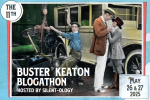 hidden in her hair, straddled by the wheels of a camera car. Keaton, directing the scene, is wearing his “working man” costume – notice the vest and the slap shoes. Next to him is a man of similar stature wearing fur shoes and a fur costume over his regular clothes. Clearly this man, and not Buster, is the person dragging Margaret by the hair in the above scene. Given Ms. Leahy’s limited acting skills, perhaps Keaton switched places to supervise the scene more closely.
hidden in her hair, straddled by the wheels of a camera car. Keaton, directing the scene, is wearing his “working man” costume – notice the vest and the slap shoes. Next to him is a man of similar stature wearing fur shoes and a fur costume over his regular clothes. Clearly this man, and not Buster, is the person dragging Margaret by the hair in the above scene. Given Ms. Leahy’s limited acting skills, perhaps Keaton switched places to supervise the scene more closely.
The movie ends with three postscript finales – caveman Buster and wife, and their 10 caveman kids exit their cave one-by-one. Next, elegant Roman Age Buster and wife and 5 children, all wearing graceful togas, exit their formal columned home. For the final shot, Present Age Buster and wife exit their Hollywood bungalow, along with … one tiny dog! As reported in this recent post, their Hollywood bungalow still stands, at 1425 El Centro near the corner of Leland Way.
Let’s look closely at Buster’s dive, filmed on long lost Court Hill above the Hill Street Tunnel, where Harold Lloyd filmed many stunt comedies.

What do you see? Buster leaping with absolute certainty he will easily grab the ledge and climb to the roof, or Buster leaping to touch the ledge so that he may deliberately fall into a net? An accident or an “accident”?
The story goes Buster accidentally missed the second building, which necessitated devising him falling through window awnings and swinging on rainspouts to salvage the failed scene.
 Considering Buster’s skill and precision, I always believed Buster’s “accidental” fall was planned that way all along. Would Buster’s brilliant technical director Fred Gabourie have failed to calibrate the correct distance for the jump in advance? To my eye the ledge was too far away for Buster to plausibly claim he was certain of success when making the leap. But Keaton scholars recount a 1956 interview where Buster reports it was a true accident, where he explains afterward “I had to go home and stay in bed for about three days.” But in Buster’s same interview he misstates where the scene was filmed (!) Knowing Buster was publicity savvy, who sometimes embellished promotional interviews, and my sense Buster really did plan for this fall, I drafted a lengthy article ‘proving’ the fall was planned all along, while dissecting Buster’s at least partially inaccurate interview describing the famous scene.
Considering Buster’s skill and precision, I always believed Buster’s “accidental” fall was planned that way all along. Would Buster’s brilliant technical director Fred Gabourie have failed to calibrate the correct distance for the jump in advance? To my eye the ledge was too far away for Buster to plausibly claim he was certain of success when making the leap. But Keaton scholars recount a 1956 interview where Buster reports it was a true accident, where he explains afterward “I had to go home and stay in bed for about three days.” But in Buster’s same interview he misstates where the scene was filmed (!) Knowing Buster was publicity savvy, who sometimes embellished promotional interviews, and my sense Buster really did plan for this fall, I drafted a lengthy article ‘proving’ the fall was planned all along, while dissecting Buster’s at least partially inaccurate interview describing the famous scene.

Buster swung on a hinged rainspout during The High Sign and swung from awning to awning during My Wife’s Relations. It’s easy to imagine Buster eagerly recreated these stunts on a large scale for his first feature film.
Thankfully eagle-eyed Keaton aficionado Richard Warner offered a tantalizing deeper theory: (A) the fall we see onscreen could have been planned, but (B) Buster was also telling the truth about having an accident. (A) and (B) are not mutually exclusive! Perhaps the sequence we see was truly planned, but also inspired by a true accident, the original footage of which is now presumably lost.

No accident here, Buster knew his limitations – this stunt is from Seven Chances
We’ll likely never know the full truth, but if you care to read why I believe Buster’s ‘accidental’ fall was truly planned that way all along, with further thoughts and images, and a full transcript of his error-prone interview, please download as a PDF below my story appearing in the Spring 2025 issue of The Keaton Chronicle, published by The International Buster Keaton Society, the Damfinos.
Buster Keaton’s Three Ages Leap of Faith by John Bengtson
Learn learn about joining the Damfinos HERE https://busterkeaton.org/.

Buster used similar sets above the Hill Street Tunnel, one detail he misremembers (!) during his 1956 interview
This post is part of the Silent-ology Buster Keaton blogathon hosted by Lea Stans. Let me know in the comments what you think about my theory.
My bonus program for the prior Kino-Lorber Blu-ray of Three Ages is now out of print, but available below on my YouTube channel. See Buster’s bathtub rock, the Garden of the Gods, the Coliseum, the Hill Street Tunnel, the Hollywood Fire/Police Station, the First Methodist Church in Glendale, and more. Please like and subscribe.
April 15, 2025
Buster Keaton’s Backlot Adventures in Cops
One of the most iconic moments in Buster Keaton’s Cops (1922), in all of cinematic history for that matter, is Buster chased back and forth down an empty city street by a mob of angry policemen.
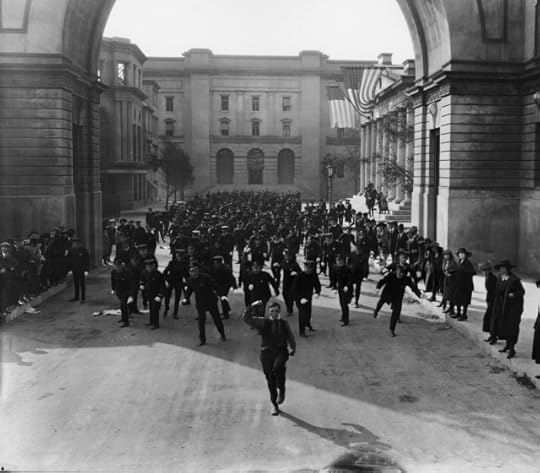 The giant buildings at back, and what I call Buster’s arch, were obviously a backlot set, and it was thrilling to see, thanks to author-historian Steve Bingen, that it once stood on the Goldwyn lot in Culver City, before later transforming into M-G-M.
The giant buildings at back, and what I call Buster’s arch, were obviously a backlot set, and it was thrilling to see, thanks to author-historian Steve Bingen, that it once stood on the Goldwyn lot in Culver City, before later transforming into M-G-M.
 Above, looking east at Buster’s arch (photo David L. Synder). I had long wondered, for what feature film were these sets originally built? Well, eagle-eyed Dave Barnes tells us – they appeared in the 1919 drama The World And Its Woman (TWAIW). Dave shares his amazing collection of classic Hollywood backlot photos on the Facebook group Studio Backlots and Ranches.
Above, looking east at Buster’s arch (photo David L. Synder). I had long wondered, for what feature film were these sets originally built? Well, eagle-eyed Dave Barnes tells us – they appeared in the 1919 drama The World And Its Woman (TWAIW). Dave shares his amazing collection of classic Hollywood backlot photos on the Facebook group Studio Backlots and Ranches.
 Above, looking west, Dave’s March 23, 2025 Facebook post shares this stunning image of the giant arch set being constructed. Considering most silent films are now lost, I was even more amazed to learn TWAIW still survives, and can be viewed online on YouTube. TWAIW is a Russian war drama depicting the forbidden love between a peasant girl turned opera star, portrayed by real-life opera star Geraldine Farrar, and a Russian prince, portrayed by Geraldine’s real-life husband Lou Tellegen.
Above, looking west, Dave’s March 23, 2025 Facebook post shares this stunning image of the giant arch set being constructed. Considering most silent films are now lost, I was even more amazed to learn TWAIW still survives, and can be viewed online on YouTube. TWAIW is a Russian war drama depicting the forbidden love between a peasant girl turned opera star, portrayed by real-life opera star Geraldine Farrar, and a Russian prince, portrayed by Geraldine’s real-life husband Lou Tellegen.
 I skimmed through the film, set entirely in Russia, and was surprised to see these grand sets only appear on camera during a few scenes at about 54 minutes into the film. YouTube link HERE. It’s remarkable they would build such huge sets for such limited screen time. Above, TWAIW to the left and Cops to the right.
I skimmed through the film, set entirely in Russia, and was surprised to see these grand sets only appear on camera during a few scenes at about 54 minutes into the film. YouTube link HERE. It’s remarkable they would build such huge sets for such limited screen time. Above, TWAIW to the left and Cops to the right.
 Count ‘Em, this July 26, 1919 publicity piece touts the film’s Fifteen Hundred Extras. Note the matching view through the arch. Megaphone in hand, Frank Lloyd was the director.
Count ‘Em, this July 26, 1919 publicity piece touts the film’s Fifteen Hundred Extras. Note the matching view through the arch. Megaphone in hand, Frank Lloyd was the director.
 Click to enlarge – looking east at the Goldwyn backlot and Buster’s arch in 1919. That’s Culver Blvd. to the right. USC Digital Library.
Click to enlarge – looking east at the Goldwyn backlot and Buster’s arch in 1919. That’s Culver Blvd. to the right. USC Digital Library.
 Above, front and back views of Buster’s arch – click to enlarge. Interestingly, while TWAIW is set in Russia, the front of the columned building in the right photo reads C”OTTON EXCHANGE,” which suggests the set was repurposed for something else, perhaps a movie set in the US south.
Above, front and back views of Buster’s arch – click to enlarge. Interestingly, while TWAIW is set in Russia, the front of the columned building in the right photo reads C”OTTON EXCHANGE,” which suggests the set was repurposed for something else, perhaps a movie set in the US south.
 Dave has more surprises. In the same March 23, 2025 Facebook post, his photo of a nearby Goldwyn set shows where Buster fooled an army of cops by hiding in a street sweeper trash can. Lon Chaney filmed a scene here as well, upper right inset, for the 1921 Goldwyn drama The Ace of Hearts.
Dave has more surprises. In the same March 23, 2025 Facebook post, his photo of a nearby Goldwyn set shows where Buster fooled an army of cops by hiding in a street sweeper trash can. Lon Chaney filmed a scene here as well, upper right inset, for the 1921 Goldwyn drama The Ace of Hearts.
As reported HERE, Cops is Buster’s only independently produced film with no interior scenes. Every scene was either filmed on location or on a studio backlot. At the time Buster’s open air shooting stage was being enclosed. It’s fun to imagine Cops was deliberately structured without interior scenes to provide the studio carpenters sufficient leeway to complete their work.
Buster not only filmed Cops on the Goldwyn backlot, but on the Metro backlot due south of his studio.

 Above, the crowd drenched while viewing the policemen’s parade, and the angry mayor yelling at his chief of police. These views look east.
Above, the crowd drenched while viewing the policemen’s parade, and the angry mayor yelling at his chief of police. These views look east.
 Buster filmed other scenes on the Metro backlot, here looking west – read more HERE.
Buster filmed other scenes on the Metro backlot, here looking west – read more HERE.
 Wrapping up, Buster filmed the pawn shop (at back) and the teeter-totter fence from Cops at the Brunton Studios (later United Studios, now the site of Paramount Studios) a few blocks east from his studio. (He also filmed many scenes here for Day Dreams, and the waterfall rescue and related scenes for Our Hospitality). Read more HERE and HERE.
Wrapping up, Buster filmed the pawn shop (at back) and the teeter-totter fence from Cops at the Brunton Studios (later United Studios, now the site of Paramount Studios) a few blocks east from his studio. (He also filmed many scenes here for Day Dreams, and the waterfall rescue and related scenes for Our Hospitality). Read more HERE and HERE.
 Every location from Cops has been identified, although this scene above hasn’t been posted before. Here, a cop pounds his baton on the ground to summon help, looking west down Market Street from Alameda toward San Pedro.
Every location from Cops has been identified, although this scene above hasn’t been posted before. Here, a cop pounds his baton on the ground to summon help, looking west down Market Street from Alameda toward San Pedro.
Every scene has been identified, well … , except for the closing scene below. I appeal once again to readers for help.
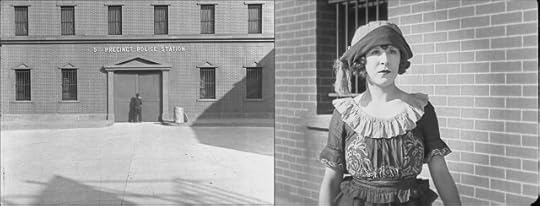
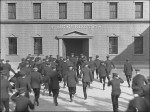 Buster locks the army of cops inside a police station, but when rejected by his girl, he turns himself in. The late afternoon sun casting shadows in the foreground suggests we are looking east. The Goldwyn scenes had far more cops. Since this scene has fewer extras, and a slightly more modest set design, I wonder if this was also filmed on the Metro backlot. I lack an aerial photo confirming this is true, but aerial photos of the Goldwyn backlot, Brunton (United) backlot, and Metro backlot, suggest it would have fit most easily on the Metro lot. Conceivably this set could have been built at Buster’s small studio itself, but it would have been one of the largest sets he ever built there, and photos taken later in 1922 do not show remnants of this set. Any thoughts?
Buster locks the army of cops inside a police station, but when rejected by his girl, he turns himself in. The late afternoon sun casting shadows in the foreground suggests we are looking east. The Goldwyn scenes had far more cops. Since this scene has fewer extras, and a slightly more modest set design, I wonder if this was also filmed on the Metro backlot. I lack an aerial photo confirming this is true, but aerial photos of the Goldwyn backlot, Brunton (United) backlot, and Metro backlot, suggest it would have fit most easily on the Metro lot. Conceivably this set could have been built at Buster’s small studio itself, but it would have been one of the largest sets he ever built there, and photos taken later in 1922 do not show remnants of this set. Any thoughts?
For me Cops is an endlessly fascinating time machine. Thanks to Dave Barnes we can now dive deeper into the past to witness and understand how Buster made this incredible film.
Check out my Kino-Lorber bonus program for College.
Check out my Kino-Lorber bonus program for Three Ages.
March 31, 2025
Silent Location Encore Performances
Short and sweet, just a few examples of silent film locations making repeat appearances. Sadly, all are long since demolished. The good news, more rare and previously unavailable silent films become accessible on YouTube every day. These YouTube links below should take you to the captured moments.
When Dawn Came (1920) starring Colleen Moore at 03:06 @DavidEickemeyer, filmed at Alameda and Marchesault, where Buster Keaton filmed a scene from Day Dreams (1922).
https://youtu.be/PTGgR69lCEc?si=t7aim6z0pv2kSsfZ&t=186

 Replaced by the Union Station, the corner of Alameda in the former Chinatown stood near the Plaza de Los Angeles.
Replaced by the Union Station, the corner of Alameda in the former Chinatown stood near the Plaza de Los Angeles.
Chicken a la King (1919) at 03:24 @josephblough4403. Another Lyons & Moran comedy, this time filmed inside the gate to Castle San Souci, where Charlie Chaplin and Marie Dressler filmed Tillie’s Punctured Romance (1914).
https://youtu.be/SG3kDjI6hDc?si=roXffCeTIP1Ig9z9&t=214
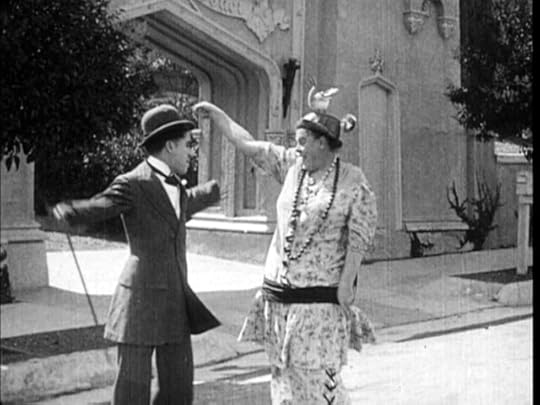 Read more about Castle San Souci here https://silentlocations.com/2017/06/12/chaplin-pavlova-lois-weber-at-the-castle-sans-souci/
Read more about Castle San Souci here https://silentlocations.com/2017/06/12/chaplin-pavlova-lois-weber-at-the-castle-sans-souci/
Lige Conley in Fast and Furious (1924) at 17:36 @josephblough4403, filming at the Inglewood train station, where Buster Keaton filmed the closing scenes from One Week (1920).
https://youtu.be/D0PLbewouiE?si=WoovyFQnkTXVJopN&t=1056

 Read more about One Week here https://silentlocations.com/2011/10/04/busters-trains-one-week-to-speak-easily/
Read more about One Week here https://silentlocations.com/2011/10/04/busters-trains-one-week-to-speak-easily/
Check out my Kino-Lorber bonus program for Three Ages.
Check out my Kino-Lorber bonus program for College.
January 15, 2025
Charlie Chaplin’s One A.M. Mystery SOLVED!!
Charlie Chaplin’s 1916 film One A.M. begins with him portraying a wealthy drunk struggling to exit a taxicab. Filmed on location, this setting has been a mystery for over a century, until Sarah Lagrillière, a brilliant film preservationist and avid visual historian from Finland (!), solved the puzzle. Incredibly, the scene was staged along Hollywood Blvd, almost due north from where Chaplin would later build his studio across a lemon grove less than 2 years later.
Click to enlarge – first, this composite photo looks south along Hollywood Blvd west of Sycamore. One movie frame shows where Charlie exits the taxi, the other movie frame matches perfectly with the back of the homes facing south along Hawthorne Ave, while the arrow leads from the filming site to the future Chaplin studio site at 1416 N La Brea. USC Digital Library. The home with the rooftop gable appearing beside the two images of Albert Austin at top was 7071 Hawthorne.
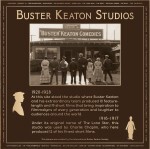 Chaplin filmed One A.M. at the Lone Star Studio, located at Eleanor and Lillian Way. Buster Keaton began his independent productions filming at the same small studio in 1920. The studio site where Chaplin AND Keaton both filmed has been honored with a commemorative plaque installed by the Damfinos, The International Buster Keaton Society.
Chaplin filmed One A.M. at the Lone Star Studio, located at Eleanor and Lillian Way. Buster Keaton began his independent productions filming at the same small studio in 1920. The studio site where Chaplin AND Keaton both filmed has been honored with a commemorative plaque installed by the Damfinos, The International Buster Keaton Society.
 Look closely and you’ll notice a trolley passes Charlie as he struggles exiting the taxi. The Lone Star Studio stood a short block south of the Santa Monica Blvd trolley line, and at the time the area was sparsely developed. It would have been efficient to film the scene on Santa Monica near the studio, but they didn’t. Analyzing vintage photos and historic maps show the details just don’t match.
Look closely and you’ll notice a trolley passes Charlie as he struggles exiting the taxi. The Lone Star Studio stood a short block south of the Santa Monica Blvd trolley line, and at the time the area was sparsely developed. It would have been efficient to film the scene on Santa Monica near the studio, but they didn’t. Analyzing vintage photos and historic maps show the details just don’t match.
The first big break came when Michael Aus released his wonderful Lyons and Moran DVD of early Universal comedy films. One featured short Waiting at the Church (1919) starring Eddie Lyons and Lee Moran (see post Time Travel to 1919 Hollywood HERE) is one of the most visually consequential silent films I’ve ever seen, with scenes filmed all around early La Brea, Highland, and nascent Hollywood Boulevard.

Click to enlarge – One A.M. at left, note trolley tracks, matching homes from Waiting at the Church at right.
As reported three years ago in a post pleading for help solving this One A.M. mystery, background details confirm Charlie, and Lyons and Moran filmed scenes at the same location. The location block pattern was clear – a vacant front lot along a trolley line, then an alley, then a back lot lined with small garages facing the alley and taller homes facing the adjacent street.

Matching details with One A.M. top and Waiting at the Church below
Further, given the angle of the light, I “assumed” the view looked east (HUGE MISTAKE). After scrutinizing vintage maps and aerial photos for candidate blocks east of trolley lines, one block along Highland Ave jumped out. The pieces all seemed to fit, no other block fit as well, and as further “proof” Lyons and Moran had filmed other scenes on McCadden Place just a block away. This had to be the correct site, but the aerial photos were too distant to say for certain.


But Waiting at the Church provided another big clue. Wider views of our location revealed a curved irrigation ditch running below the street with the trolley line, guarded by a metal safety railing (above) to protect people from falling into the ditch. Charlie must have exited his taxi near this railing. All we needed to prove this Highland block was correct was to track down some early adjacent drainage or irrigation channel.
 Three years ago I pleaded for help, and Al Donnelly came aboard. A Hollywood area native, now retired in Oregon, Al is an expert historian, focusing on railroads and infrastructure. Al sent numerous vintage maps, construction plans, diagrams, and early photos that we dissected trying to find some tangible clue placing a canal or ditch adjacent to Highland. One remarkable document, Al shared this 1888 irrigation map showing Colegrove, and where Hollywood would later be developed, covered with a grid of canals and ditches. But again, these records were just too broad to confirm a single ditch at a single spot. David Rumsey Historical Map Collection.
Three years ago I pleaded for help, and Al Donnelly came aboard. A Hollywood area native, now retired in Oregon, Al is an expert historian, focusing on railroads and infrastructure. Al sent numerous vintage maps, construction plans, diagrams, and early photos that we dissected trying to find some tangible clue placing a canal or ditch adjacent to Highland. One remarkable document, Al shared this 1888 irrigation map showing Colegrove, and where Hollywood would later be developed, covered with a grid of canals and ditches. But again, these records were just too broad to confirm a single ditch at a single spot. David Rumsey Historical Map Collection.
 Then, out of the blue three years later, Sarah Lagrillière emailed the answer from Finland, the Chaplin One A.M. mystery was finally solved! Sarah is brilliant, and did several brilliant things. First, she didn’t fall for my assumption the view looked east (it looks south). She allowed herself to consider all possibilities. Next, she didn’t focus on some canal or ditch, she focused on the distinctive homes appearing at back. Studying vintage photos, some presented in my post about early Hollywood, before the Chaplin Studio was built, the corner of Hollywood and Sycamore stood out to her. Plain as day, she saw what I had overlooked. I am so happy she shared this with us.
Then, out of the blue three years later, Sarah Lagrillière emailed the answer from Finland, the Chaplin One A.M. mystery was finally solved! Sarah is brilliant, and did several brilliant things. First, she didn’t fall for my assumption the view looked east (it looks south). She allowed herself to consider all possibilities. Next, she didn’t focus on some canal or ditch, she focused on the distinctive homes appearing at back. Studying vintage photos, some presented in my post about early Hollywood, before the Chaplin Studio was built, the corner of Hollywood and Sycamore stood out to her. Plain as day, she saw what I had overlooked. I am so happy she shared this with us.
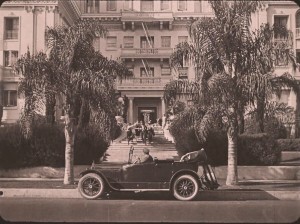 Charlie’s choice of location is puzzling. The mundane background does not suggest the urban nightclub life, and why would he travel two miles for such a generic shot on Hollywood Blvd when a comparable bland background was available right at his Mutual studio? Further, the spot was just steps to the west from the fabulous (now lost) Garden Court luxury apartments. One A.M. was released August 7, 1916, and a Hollywood historian reports the Garden Court was built in 1916. At left, the Garden Court appears in the 1922 promotional film Night Life in Hollywood hosted on YouTube by Joseph Blough.
Charlie’s choice of location is puzzling. The mundane background does not suggest the urban nightclub life, and why would he travel two miles for such a generic shot on Hollywood Blvd when a comparable bland background was available right at his Mutual studio? Further, the spot was just steps to the west from the fabulous (now lost) Garden Court luxury apartments. One A.M. was released August 7, 1916, and a Hollywood historian reports the Garden Court was built in 1916. At left, the Garden Court appears in the 1922 promotional film Night Life in Hollywood hosted on YouTube by Joseph Blough.
It seems unlikely, but if, if, the completed building and the movie filming overlapped, perhaps Charlie originally filmed at the Garden Court. Charlie portrays a wealthy drunk, so what if they decided to film at one of the few fancy buildings in town? Again, this is speculation, not likely, but imagine Charlie then realized this lavish building in the background would distract from him getting out of the cab, so he simply moved just down the street instead. What do you think? Does some theory explain why Charlie filmed this scene two miles from his studio?
 Click to enlarge – more context, Sarah suggests the arrow seems to point toward the same tree in both this 1919 Watson Family Archive aerial photo and in this 1919 Waiting at the Church frame. Notice the large white Garden Court Apartments near the center. Note: the tip of the triangular traffic island in the aerial photo is where Buster Keaton built his private safe doorway set in Sherlock Jr. (1924).
Click to enlarge – more context, Sarah suggests the arrow seems to point toward the same tree in both this 1919 Watson Family Archive aerial photo and in this 1919 Waiting at the Church frame. Notice the large white Garden Court Apartments near the center. Note: the tip of the triangular traffic island in the aerial photo is where Buster Keaton built his private safe doorway set in Sherlock Jr. (1924).
 Click to enlarge – this 1918 Charlie Chaplin Archive photo looking north shows the Chaplin Studio lower right, with the above-ground backlot “trench” set built for Shoulder Arms. I decided not to annotate this photo, but hopefully you can clearly see the Garden Court, Sycamore, Hawthorne, and the One A.M. vacant lot filming site near the top.
Click to enlarge – this 1918 Charlie Chaplin Archive photo looking north shows the Chaplin Studio lower right, with the above-ground backlot “trench” set built for Shoulder Arms. I decided not to annotate this photo, but hopefully you can clearly see the Garden Court, Sycamore, Hawthorne, and the One A.M. vacant lot filming site near the top.
Click to enlarge – for comparison, this circa 1906 photo looking south shows Sycamore, with a few homes on Hawthorne facing the camera. USC Digital Library.
Thanks again to Sarah Lagrillière, Al Donnelly, Michael Aus, and the others who offered suggestions over the years, for uncovering a tantalizing glimpse of early Hollywood history.
 Then and now – 7060 Hollywood Blvd west of Sycamore
Then and now – 7060 Hollywood Blvd west of Sycamore
Charlie’s studio on La Brea was once a lemon grove. This YouTube video shows more of Charlie’s studio neighborhood.
November 3, 2024
How Laurel & Hardy Made “Two Tars”
 They did it again! Flicker Alley is now hosting Laurel & Hardy: Year Two, a beautifully presented 2-disc Blu-ray set of Stan and Ollie’s 1928 films, their second year (Year Two) working as a duo. These all-new restorations were assembled from archives and collectors from around the world, and once again I was honored to present a bonus video essay providing a detailed overview of the locations appearing in such films as Leave ‘Em Laughing, The Finishing Touch, You’re Darn Tootin’, Their Purple Moment, Should Married Men Go Home?, Two Tars, and We Faw Down.
They did it again! Flicker Alley is now hosting Laurel & Hardy: Year Two, a beautifully presented 2-disc Blu-ray set of Stan and Ollie’s 1928 films, their second year (Year Two) working as a duo. These all-new restorations were assembled from archives and collectors from around the world, and once again I was honored to present a bonus video essay providing a detailed overview of the locations appearing in such films as Leave ‘Em Laughing, The Finishing Touch, You’re Darn Tootin’, Their Purple Moment, Should Married Men Go Home?, Two Tars, and We Faw Down.
 Many of these 1928 locations were discovered long ago by Robert Satterfield and other devoted location fans, as documented in Pratfall, the 1985 Way Out West Tent filming location guide. That said, while researching the visual essay I came upon several new locations that do not appear to have been previously reported. To see them all check out the new Year Two locations program. This post focuses on Two Tars, famous for its slow-motion demolition derby among frustrated drivers stuck in a rural traffic jam.
Many of these 1928 locations were discovered long ago by Robert Satterfield and other devoted location fans, as documented in Pratfall, the 1985 Way Out West Tent filming location guide. That said, while researching the visual essay I came upon several new locations that do not appear to have been previously reported. To see them all check out the new Year Two locations program. This post focuses on Two Tars, famous for its slow-motion demolition derby among frustrated drivers stuck in a rural traffic jam.

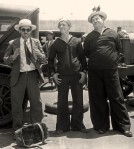 Hal Roach Studio carpenter and prop man Thomas Benton Roberts (who built the many collapsing cars, see his cameo at left) reported the traffic jam was staged along Centinella Avenue, as does the 1928 Studio Date Book. Newly reported here, convincing photographic evidence seems to confirm it was staged along Centinella a block or two south of the Clover Airfield, the corner of National Blvd, and the Santa Monica Golf Course (see map above, more details to follow). While a nearby street has been proposed as the location instead, vintage aerial photos and maps show this street was not constructed until after the movie was made.
Hal Roach Studio carpenter and prop man Thomas Benton Roberts (who built the many collapsing cars, see his cameo at left) reported the traffic jam was staged along Centinella Avenue, as does the 1928 Studio Date Book. Newly reported here, convincing photographic evidence seems to confirm it was staged along Centinella a block or two south of the Clover Airfield, the corner of National Blvd, and the Santa Monica Golf Course (see map above, more details to follow). While a nearby street has been proposed as the location instead, vintage aerial photos and maps show this street was not constructed until after the movie was made.
 A quick example, more details below – the crest of the hill and the trees marked red and orange in the aerial view at right (looking north up Centinella) stand at the corner of National Blvd, and seem to match these trees in the film.
A quick example, more details below – the crest of the hill and the trees marked red and orange in the aerial view at right (looking north up Centinella) stand at the corner of National Blvd, and seem to match these trees in the film.
 The film begins with Stan and Ollie, two sailors on shore leave, driving a rental car north up Main Street in (where else?) Culver City, a few blocks west from the Roach Studio.
The film begins with Stan and Ollie, two sailors on shore leave, driving a rental car north up Main Street in (where else?) Culver City, a few blocks west from the Roach Studio.
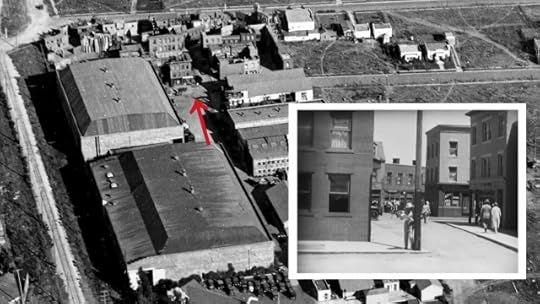 Enjoying their automotive freedom, Stan mindlessly drives straight toward a telephone pole on the Roach Studio backlot, barely missing it.
Enjoying their automotive freedom, Stan mindlessly drives straight toward a telephone pole on the Roach Studio backlot, barely missing it.
 After scolding Stan to always keep his eyes straight ahead, Ollie takes the wheel, driving past the entrance to The Pink Pup, appearing in Their Purple Moment (right), before smashing into a corner lamp post.
After scolding Stan to always keep his eyes straight ahead, Ollie takes the wheel, driving past the entrance to The Pink Pup, appearing in Their Purple Moment (right), before smashing into a corner lamp post.
 Click to enlarge – looking south, this aerial view of the former Roach Studio backlot, once standing at 8822 W Washington Blvd. in Culver City, highlights the corner where Ollie hits the lamp post and The Pink Pup entrance. Standing in front of the car, the corner with the telephone pole is blocked from view. Marc Wanamaker – Bison Archives.
Click to enlarge – looking south, this aerial view of the former Roach Studio backlot, once standing at 8822 W Washington Blvd. in Culver City, highlights the corner where Ollie hits the lamp post and The Pink Pup entrance. Standing in front of the car, the corner with the telephone pole is blocked from view. Marc Wanamaker – Bison Archives.
 Further scenes were filmed back on Main Street, including then and now views of the Boys stopping to flirt with Thelma Hill and Ruby Blaine. Their car faces south, with 3838-3840 Main behind them. Photo Bob Borgen.
Further scenes were filmed back on Main Street, including then and now views of the Boys stopping to flirt with Thelma Hill and Ruby Blaine. Their car faces south, with 3838-3840 Main behind them. Photo Bob Borgen.
 Now looking north – notice the prominent “PLUMBING” sign painted on the wall of 3808 Main Street, then standing beside a vacant lot.
Now looking north – notice the prominent “PLUMBING” sign painted on the wall of 3808 Main Street, then standing beside a vacant lot.
 Three views looking north up Main toward the corner of Venice Blvd. with the once exposed “PLUMBING” sign highlighted. Photo Bob Borgen.
Three views looking north up Main toward the corner of Venice Blvd. with the once exposed “PLUMBING” sign highlighted. Photo Bob Borgen. The gumball scenes with the girls and Charlie Hall were filmed on the backlot. The matching details show Charlie’s store had portrayed the ABC Restaurant before in You’re Darn Tootin’. Click to enlarge – do Stan’s hands seem to be somewhat occupied?
The gumball scenes with the girls and Charlie Hall were filmed on the backlot. The matching details show Charlie’s store had portrayed the ABC Restaurant before in You’re Darn Tootin’. Click to enlarge – do Stan’s hands seem to be somewhat occupied?
 Click to enlarge – looking east, this 1928 aerial view of Centinela, running north-south (left-right) toward the corner of National, seems to match the traffic jam road. Notice the isolated home (yellow) standing west of Centinela. FrameFinder c-300_j-286
Click to enlarge – looking east, this 1928 aerial view of Centinela, running north-south (left-right) toward the corner of National, seems to match the traffic jam road. Notice the isolated home (yellow) standing west of Centinela. FrameFinder c-300_j-286
 The bluffs of Playa del Rey at back (orange) confirm the traffic jam road looks south. The traffic jam home in the movie (yellow) appears to match perfectly with the isolated home west of Centinela (inset) identified in the prior aerial photo. Both square homes have peaked pyramid roofs, small side awnings to the left, and narrow wings along the back. These matching homes, other consistent details, and the lack of other credible, alternative candidate locations, convinces me this is the correct spot.
The bluffs of Playa del Rey at back (orange) confirm the traffic jam road looks south. The traffic jam home in the movie (yellow) appears to match perfectly with the isolated home west of Centinela (inset) identified in the prior aerial photo. Both square homes have peaked pyramid roofs, small side awnings to the left, and narrow wings along the back. These matching homes, other consistent details, and the lack of other credible, alternative candidate locations, convinces me this is the correct spot.


Robert Satterfield reports in Pratfall the Centinela filming centered around what is now Rose Ave. The maps and aerials seem to confirm this is generally correct. Of course the cars stretched for blocks, and I would place the Boys a bit further north. Since Centinela is completely built over and unrecognizable, the precise spots are now lost to history. See 3245 S. Centinela on Google Maps at the end of this post. Photos Bob Borgen.
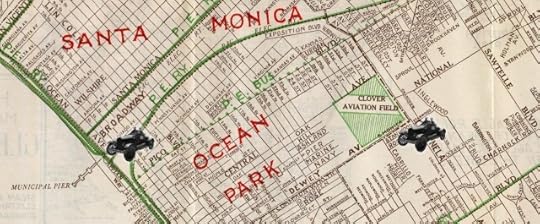 The film ends near the Santa Monica Pier, a popular amusement park now for over 100 years.
The film ends near the Santa Monica Pier, a popular amusement park now for over 100 years.
 The Loof Carousel-Hippodrome, still standing (color inset), appears at right. The popular “merry-go-round” carousel played important scenes during 1973’s “Best Picture” The Sting. Notice the wooden framed tunnel and wooden stairs to the left. Huntington Digital Library.
The Loof Carousel-Hippodrome, still standing (color inset), appears at right. The popular “merry-go-round” carousel played important scenes during 1973’s “Best Picture” The Sting. Notice the wooden framed tunnel and wooden stairs to the left. Huntington Digital Library.
 Pursued by angry motorists, the Boys hide inside a train tunnel. Near the pier, this tunnel ran beneath Colorado Avenue and once served early trolley and rail lines running north along the coast. Huntington Digital Library.
Pursued by angry motorists, the Boys hide inside a train tunnel. Near the pier, this tunnel ran beneath Colorado Avenue and once served early trolley and rail lines running north along the coast. Huntington Digital Library.
 The Boys survive the outgoing train, but if you look closely their powerless, non-motorized auto, built for them by Thomas Benton Roberts, is towed from the tunnel by wires. Huntington Digital Library.
The Boys survive the outgoing train, but if you look closely their powerless, non-motorized auto, built for them by Thomas Benton Roberts, is towed from the tunnel by wires. Huntington Digital Library.
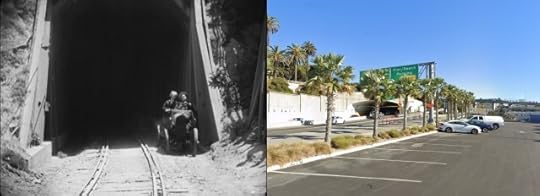 The closing shot, ending our Two Tars tour. This once simple tunnel now leads traffic from the Santa Monica Freeway north onto the Pacific Coast Highway.
The closing shot, ending our Two Tars tour. This once simple tunnel now leads traffic from the Santa Monica Freeway north onto the Pacific Coast Highway.


Click to enlarge – as mentioned, the Year Two bonus program highlights many other 1928 locations, such as these newly reported views from The Finishing Touch …
 … and these views from Should Married Men Go Home?
… and these views from Should Married Men Go Home?
Be sure to order Flicker Alley’s Laurel & Hardy: Year Two – I hope you’ll enjoy the new Year Two bonus program. I want to thank Flicker for once again inviting me to prepare a program, the Flicker editors Nate Sutton and Silas Lesnick for their hard work, and my friend Bob Borgen for taking and sharing so many color photos.
My YouTube channel hosts my latest video – the many new discoveries in how Buster Keaton filmed Go West.
Two Tars – Centinela on Google Maps.
October 19, 2024
Buster Keaton Go West – many NEW discoveries on a new YouTube essay
Thanks to the brilliant research by frequent guest blogger Jeffrey Castel de Oro, and the beautiful remote Arizona desert photos shared by dedicated EPA attorney and devoted Keaton fan Marie Muller, we can ‘visit’ online today essentially all of the locations from Buster Keaton’s self-directed film Go West (1925), far more than as reported in my book Silent Echoes and in recent posts Go West blog index. You’ll see a few new discoveries below, but all of these many new discoveries are clearly presented in my visual essay for the Eureka Entertainment Masters of Cinema Blu-ray release of Go West.
This essay marks the 19th video hosted on my Silent Locations YouTube channel.
 Above, the very spot where Buster was inspired to ‘Go West,’ still stands behind 861 Traction Avenue in downtown LA – as reported in Jeff’s guest blog HERE.
Above, the very spot where Buster was inspired to ‘Go West,’ still stands behind 861 Traction Avenue in downtown LA – as reported in Jeff’s guest blog HERE.
 Never before posted, the closing scenes featured the Union Stock Yard just five miles southeast from downtown. The dome of the livestock sales pavilion appears at back.
Never before posted, the closing scenes featured the Union Stock Yard just five miles southeast from downtown. The dome of the livestock sales pavilion appears at back.
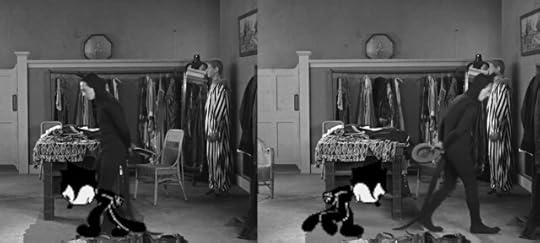 To lure the cattle Buster puts on a red devil costume, but his trademark porkpie hat won’t fit over the horns. What to do? As Buster ponders his dilemma, pacing back and forth, contemporary audiences would have instantly recognized he was mimicking Felix the Cat, then a popular animated star. This was the final scene Buster’s character wore his porkpie hat during Keaton’s independent films. (During Steamboat Bill, Jr. (1928), as Buster tries on various hats in front of a mirror, a frustrated salesman slams a porkpie hat on his head that Buster quickly removes.)
To lure the cattle Buster puts on a red devil costume, but his trademark porkpie hat won’t fit over the horns. What to do? As Buster ponders his dilemma, pacing back and forth, contemporary audiences would have instantly recognized he was mimicking Felix the Cat, then a popular animated star. This was the final scene Buster’s character wore his porkpie hat during Keaton’s independent films. (During Steamboat Bill, Jr. (1928), as Buster tries on various hats in front of a mirror, a frustrated salesman slams a porkpie hat on his head that Buster quickly removes.)



Click to enlarge – another new discovery (there are many more, please watch) as Buster flees the cattle running west along Hollywood Blvd. you can first see his camera car reflected in the window, and then the reflection of the curved stairway entrance to the lost Garden Court Apartments that once stood at 7030 Hollywood Blvd. at the corner of N. Sycamore.
Check out the many Chaplin, Keaton, and Lloyd videos hosted on my Silent Locations YouTube channel. Below, my new video for Charlie Chaplin’s The Circus (1928), with new discoveries about its dramatic closing finale as Charlie walks away alone.
You can access all the other Go West blog posts here Go West blog index. Go West also has ties to Clark Gable and Carole Lombard, Route 66, Riverside, and Safety Last! Enjoy the show to learn how. Eureka Entertainment Masters of Cinema Blu-ray release of Go West.
Below, near Tap Duncan’s Valley Ranch, where Buster meets Brown Eyes.
September 13, 2024
Buster Keaton – the Great SMILING Stoneface
Buster Keaton – “The Great Stoneface” – the child vaudeville performer who famously never smiled on stage, the silent comedy star who promoted his deadpan persona on film. Yet working with friend and mentor Roscoe Arbuckle, Buster started his film career in 1917 with a very different vibe, laughing and smiling with joy and glee.
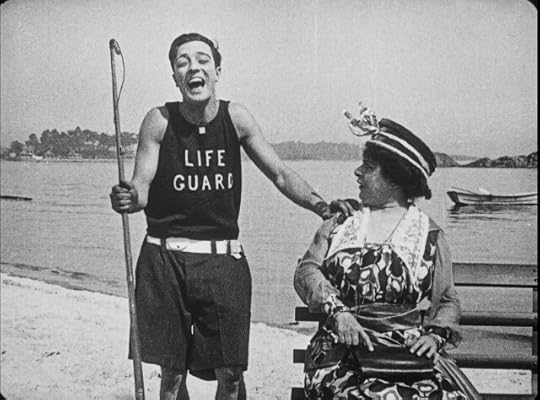 Studying his Arbuckle films closely – spoiler ahead – I was stunned to discover Buster smiles to some degree in EVERY ONE of their films (granted, catching Buster smiling during Back Stage is a close call). Buster engages in other non-deadpan antics as well.
Studying his Arbuckle films closely – spoiler ahead – I was stunned to discover Buster smiles to some degree in EVERY ONE of their films (granted, catching Buster smiling during Back Stage is a close call). Buster engages in other non-deadpan antics as well.
 Was Buster simply following director Arbuckle’s instructions? Was Buster experimenting, finding his way, rebelling against his father Joe’s strict onstage rules “Face! Face! Freeze the puss!”? Or, being happy and free, on his own for the first time in his young adult life, was he simply having too much fun, getting it out of his system, intuitively knowing he’d resume the deadpan later for his solo career?
Was Buster simply following director Arbuckle’s instructions? Was Buster experimenting, finding his way, rebelling against his father Joe’s strict onstage rules “Face! Face! Freeze the puss!”? Or, being happy and free, on his own for the first time in his young adult life, was he simply having too much fun, getting it out of his system, intuitively knowing he’d resume the deadpan later for his solo career?
Keaton fans are familiar with Buster’s debut appearance on film in The Butcher Boy. A chance meeting on an New York street, an intriguing invitation, and so Buster visits Roscoe Arbuckle’s studio to give film a try. But look at what the movie reveals.
 To begin, Buster smiles at Roscoe during their very first onscreen encounter, when Buster ‘remembers’ he left the coins to pay for his molasses in the bottom of the bucket. That didn’t take long – Buster broke his deadpan rule his first time at bat.
To begin, Buster smiles at Roscoe during their very first onscreen encounter, when Buster ‘remembers’ he left the coins to pay for his molasses in the bottom of the bucket. That didn’t take long – Buster broke his deadpan rule his first time at bat.
 Moments later, reentering the store, Buster smiles gesturing to another customer “hey, I forgot my hat.”
Moments later, reentering the store, Buster smiles gesturing to another customer “hey, I forgot my hat.”
 Back inside, Buster is famously knocked to the floor by a sack of flour, his debut cinematic pratfall. Buster relates Roscoe told him it’s hard not to flinch when you’re expecting to get hit, so look the over way, and when Roscoe says “turn,” turn, and the flour sack will be there. The trick works, and as Buster liked to recall, “it put my feet where my head had been.” But then what does Buster do?
Back inside, Buster is famously knocked to the floor by a sack of flour, his debut cinematic pratfall. Buster relates Roscoe told him it’s hard not to flinch when you’re expecting to get hit, so look the over way, and when Roscoe says “turn,” turn, and the flour sack will be there. The trick works, and as Buster liked to recall, “it put my feet where my head had been.” But then what does Buster do?
 Buster retaliates by throwing a pie! Left-handed as well, so he won’t block view of the action with his body as he flings the pastry stage left. This is the first of only two pies tossed during his entire silent film career (the second was in The Garage), and it’s literally his first day on camera. Since pie-throwing had become somewhat passé by 1917, blogger Lea Stans of Silent-ology fame wonders whether this might have even been a bit of an inside joke — Buster demanding with mock indignation, “What, give up my stage career for some two-bit flicker? I refuse unless you let me toss a pie!”
Buster retaliates by throwing a pie! Left-handed as well, so he won’t block view of the action with his body as he flings the pastry stage left. This is the first of only two pies tossed during his entire silent film career (the second was in The Garage), and it’s literally his first day on camera. Since pie-throwing had become somewhat passé by 1917, blogger Lea Stans of Silent-ology fame wonders whether this might have even been a bit of an inside joke — Buster demanding with mock indignation, “What, give up my stage career for some two-bit flicker? I refuse unless you let me toss a pie!”
 Struck by the pie (see further above), Arbuckle’s co-star and nephew Al St. John returns fire with another bag of flour, missing Buster, and striking that other customer in the face. Buster’s response is to double over laughing at the man’s misfortune.
Struck by the pie (see further above), Arbuckle’s co-star and nephew Al St. John returns fire with another bag of flour, missing Buster, and striking that other customer in the face. Buster’s response is to double over laughing at the man’s misfortune.
 Reel two of The Butcher Boy takes place at a girl’s boarding school, where Roscoe’s sweetheart portrayed by Josephine Stevens is exiled. When Roscoe gains entry disguised as a girl, Buster assists Al to gain entry with a similar female disguise. Here, Buster delights at Al’s ridiculous costume.
Reel two of The Butcher Boy takes place at a girl’s boarding school, where Roscoe’s sweetheart portrayed by Josephine Stevens is exiled. When Roscoe gains entry disguised as a girl, Buster assists Al to gain entry with a similar female disguise. Here, Buster delights at Al’s ridiculous costume.
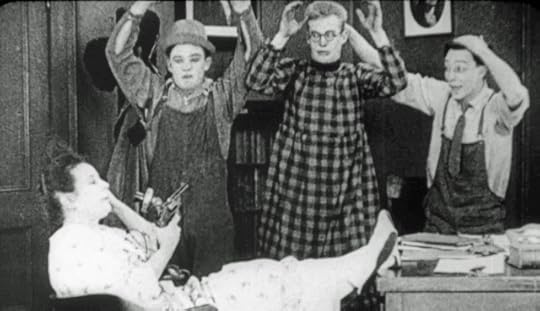 Later, as intruders held at gunpoint by the school headmistress, Buster smiles to reassure her they aren’t really a threat. In all, a fan familiar with Keaton’s stage work, eager to witness his first onscreen appearance, might very well have wondered “this is frozen-faced Buster?”
Later, as intruders held at gunpoint by the school headmistress, Buster smiles to reassure her they aren’t really a threat. In all, a fan familiar with Keaton’s stage work, eager to witness his first onscreen appearance, might very well have wondered “this is frozen-faced Buster?”
 In The Rough House (above) Buster plays both a bearded gardener and a delivery boy. While barely a glimmer of a smile escapes Buster’s lips as he assists Roscoe with the garden hose, his unique makeup alone deserves mention.
In The Rough House (above) Buster plays both a bearded gardener and a delivery boy. While barely a glimmer of a smile escapes Buster’s lips as he assists Roscoe with the garden hose, his unique makeup alone deserves mention.
 Next, delivery boy Buster flirts with Josephine Stevens, displaying a more subtle, close-mouthed grin.
Next, delivery boy Buster flirts with Josephine Stevens, displaying a more subtle, close-mouthed grin.
 Next, Buster returns to his more characteristic smile, laughing in derision at Al’s calamity.
Next, Buster returns to his more characteristic smile, laughing in derision at Al’s calamity.
 The cops break up Al and Buster’s fight and drag them to jail. When offered positions on the police force in lieu of imprisonment, Buster and Al’s mutual smile seal their accord.
The cops break up Al and Buster’s fight and drag them to jail. When offered positions on the police force in lieu of imprisonment, Buster and Al’s mutual smile seal their accord.
 During His Wedding Night, Buster delivers a wedding dress to Roscoe’s fiancé portrayed by Alice Mann. Buster’s reward for winking suggestively to Roscoe, thanks to a large speck of dust lodged in his eye, is a hearty glass of ale that puts Buster in a visibly happier mood.
During His Wedding Night, Buster delivers a wedding dress to Roscoe’s fiancé portrayed by Alice Mann. Buster’s reward for winking suggestively to Roscoe, thanks to a large speck of dust lodged in his eye, is a hearty glass of ale that puts Buster in a visibly happier mood.
 Unaware Buster is modeling the wedding dress for Alice’s prior visual inspection, Al mistakenly kidnaps the fully veiled Buster (not Alice) from the store in a forced elopement. Remarkably, this two story set (above), replete with a horse carriage and dirt road, was an interior set contained within the upper floor glass shooting stage of the Biograph Studio in the Bronx, several stories above the street.
Unaware Buster is modeling the wedding dress for Alice’s prior visual inspection, Al mistakenly kidnaps the fully veiled Buster (not Alice) from the store in a forced elopement. Remarkably, this two story set (above), replete with a horse carriage and dirt road, was an interior set contained within the upper floor glass shooting stage of the Biograph Studio in the Bronx, several stories above the street.
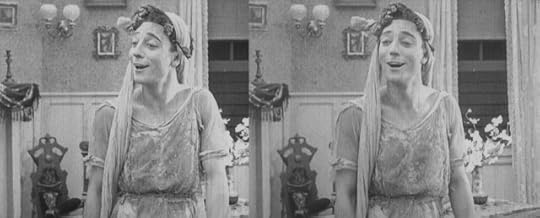 After being forcibly married to Al, while still shrouded incognito, and then recovering from a blow to the head, Buster, now unveiled, seems quite pleased with his marital status.
After being forcibly married to Al, while still shrouded incognito, and then recovering from a blow to the head, Buster, now unveiled, seems quite pleased with his marital status.
 During Oh Doctor!, Buster portrays Roscoe’s bratty son. While Buster receives parental abuse from Dad, Buster in turn ridicules Dad with showers of mocking laughter over his misfortune betting on losing horses. Oh Doctor! ranks among Buster’s least ‘stoneface-ish’ performances. First the laughter –
During Oh Doctor!, Buster portrays Roscoe’s bratty son. While Buster receives parental abuse from Dad, Buster in turn ridicules Dad with showers of mocking laughter over his misfortune betting on losing horses. Oh Doctor! ranks among Buster’s least ‘stoneface-ish’ performances. First the laughter –
 – then the tears. You can still visit that street corner on the left today, at the NW corner of W 246th and Fieldston in the Bronx.
– then the tears. You can still visit that street corner on the left today, at the NW corner of W 246th and Fieldston in the Bronx.
 Many other Arbuckle-Keaton Bronx exterior film locations from Oh Doctor! may still be visited. Above, looking along E 175th St towards the corner of 1801 Marmion. Read a detailed blog about touring the Biograph Studio studio filming sites HERE.
Many other Arbuckle-Keaton Bronx exterior film locations from Oh Doctor! may still be visited. Above, looking along E 175th St towards the corner of 1801 Marmion. Read a detailed blog about touring the Biograph Studio studio filming sites HERE.
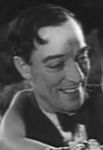 Many more Keaton smiles will be covered in later posts. If you can’t wait, you may access a 13MB pdf file outlining each Arbuckle-Keaton smile from a two-part series of stories I contributed to Comique Magazine, edited by Paul E. Gierucki, David B. Pearson, and Eryn Merwart. Click to download the full two-part story HERE. You can also read the two stories online.
Many more Keaton smiles will be covered in later posts. If you can’t wait, you may access a 13MB pdf file outlining each Arbuckle-Keaton smile from a two-part series of stories I contributed to Comique Magazine, edited by Paul E. Gierucki, David B. Pearson, and Eryn Merwart. Click to download the full two-part story HERE. You can also read the two stories online.
The link to my article for Vol. 1, page 32 https://archive.org/details/ComiqueMagazine1/page/32/mode/2up
The link to my article for Vol. 2, page 94 https://archive.org/details/comique-the-classic-comedy-magazine-issue-no.-2/page/94/mode/2up
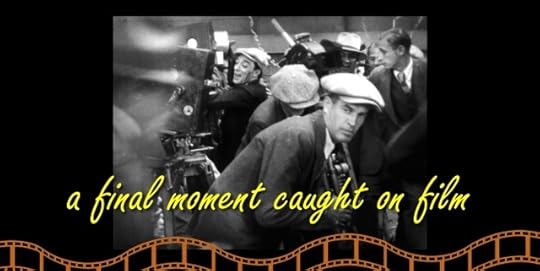 In closing, Buster even smiled once during The Cameraman, the closing moment from my latest YouTube video about the many locations where Buster made the film.
In closing, Buster even smiled once during The Cameraman, the closing moment from my latest YouTube video about the many locations where Buster made the film.
July 30, 2024
Caught On Film – Buster Keaton’s The Cameraman
Silent Locations has over 10 posts about various aspects of The Cameraman; filming in Hollywood, at M-G-M, around New York, in Santa Monica, Newport Beach, and so on.
My new YouTube video compiles these posts and even more discoveries into a single show.
 Click above to watch the video – score by Jon C. Mirsalis. Not just all the locations, moving to M-G-M, and Buster’s rented bungalow right outside, hidden details reveal how filming at long-familiar locales, and near where he had once worked happily with mentor/best friend Roscoe Arbuckle, must have given Keaton some comfort during this difficult transition in his life. Click to enlarge each image.
Click above to watch the video – score by Jon C. Mirsalis. Not just all the locations, moving to M-G-M, and Buster’s rented bungalow right outside, hidden details reveal how filming at long-familiar locales, and near where he had once worked happily with mentor/best friend Roscoe Arbuckle, must have given Keaton some comfort during this difficult transition in his life. Click to enlarge each image.


A few of the many “New York” scenes filmed at the M-G-M backlot, just two blocks west of the bungalow on 10132 Grant Ave. Buster rented as a dressing room outside the studio.


Buster and Marceline Day filmed their date bathing at the Venice Plunge, then sought a ride back home at the pier in Santa Monica, where Buster is caught in the rain. Fun fact – the automobile rain scenes were staged as if this was filmed on a real street. We never see the ocean or the edge of the pier during the movie, that’s why it took so long to discover.
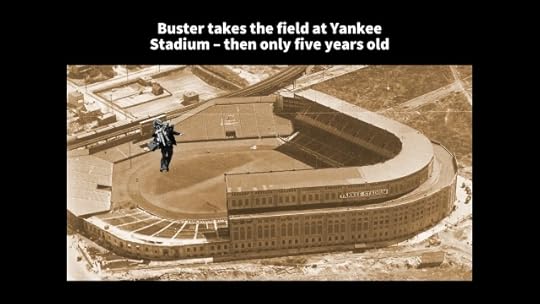 Buster filmed scenes at Yankee Stadium.
Buster filmed scenes at Yankee Stadium.
 The New York street where Buster lived – Marceline’s New York street is also shown.
The New York street where Buster lived – Marceline’s New York street is also shown.
 Running to Marceline’s apartment, Buster turned west on West 58th from 5th Ave. past Bergdorf-Goodman. This was geographically correct – it turns out her home exterior on 35 West 58th was just down the street.
Running to Marceline’s apartment, Buster turned west on West 58th from 5th Ave. past Bergdorf-Goodman. This was geographically correct – it turns out her home exterior on 35 West 58th was just down the street.


Buster had already made four movies at Newport Beach, so returning here must have been familiar and reassuring during the challenges of losing his studio and becoming a cog in the M-G-M machine. Vintage aerial views show how different things looked at the time.



To film a closing scene from The Cameraman, Buster drove from his bungalow along Motor Ave. past where he filmed scenes from The Garage (1919) with Roscoe Arbuckle.
 Spoiler – the video ends with a happy final moment caught on film.
Spoiler – the video ends with a happy final moment caught on film.
 Criterion’s The Cameraman Blu-ray is loaded with extras, including Oscar-nominated Daniel Raim’s 2020 documentary Time Travelers: Uncovering Old LA in Keaton Comedies, revealing newly discovered connections between Keaton’s MGM debut and the earliest films of his career, featuring your truly and legendary Hollywood historian Marc Wanamaker. The Criterion Blu-ray is wonderful – I encourage every Keaton fan to purchase a copy. I hope too you will check out my Caught on Film – The Cameraman video, and the nearly twenty other videos on my YouTube Channel.
Criterion’s The Cameraman Blu-ray is loaded with extras, including Oscar-nominated Daniel Raim’s 2020 documentary Time Travelers: Uncovering Old LA in Keaton Comedies, revealing newly discovered connections between Keaton’s MGM debut and the earliest films of his career, featuring your truly and legendary Hollywood historian Marc Wanamaker. The Criterion Blu-ray is wonderful – I encourage every Keaton fan to purchase a copy. I hope too you will check out my Caught on Film – The Cameraman video, and the nearly twenty other videos on my YouTube Channel.
June 29, 2024
Mack Swain’s Santa Monica Adventures with Laurel & Hardy, Chaplin, Keaton, and Lloyd
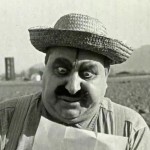 Imagine a “lost” silent film providing detailed views of where Laurel & Hardy, Roscoe Arbuckle, Buster Keaton, Harold Lloyd, and Charlie Chaplin once filmed. This time it’s the 1918 Mack Swain L-KO comedy Adventurous Ambrose, a beautiful scanned print from the Library of Congress hosted on Joseph Blough’s wonderful YouTube channel.
Imagine a “lost” silent film providing detailed views of where Laurel & Hardy, Roscoe Arbuckle, Buster Keaton, Harold Lloyd, and Charlie Chaplin once filmed. This time it’s the 1918 Mack Swain L-KO comedy Adventurous Ambrose, a beautiful scanned print from the Library of Congress hosted on Joseph Blough’s wonderful YouTube channel.


Click to enlarge all the images. The fun begins when farmer Mack learns he has inherited a beach-side hotel. Hilarity ensues when guests with similar names create slapstick mistaken identity chaos. Above left, a husband catches the Venice Short Line trolley, on Venice Blvd. looking east at the SE corner of Main St. in Culver City, leaving his wife behind to catch the next train. A decade later Stan Laurel and Oliver Hardy would flee the police at the same corner during The Second Hundred Years (1927), above right.
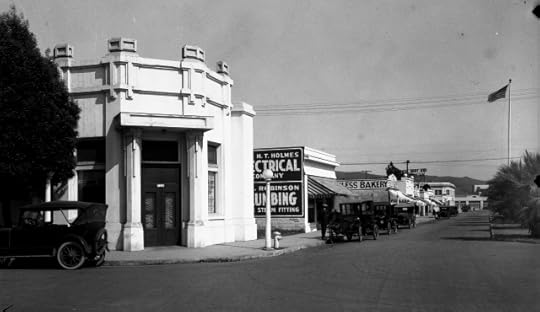 You can see the planters that once ran down the center of Main, both directly above, and in the above left movie frame. UCLA Library Digital Collections.
You can see the planters that once ran down the center of Main, both directly above, and in the above left movie frame. UCLA Library Digital Collections.


Working from the Lehrman (Lehrman Knock Out Comedies (L-KO) Studio, Roscoe Arbuckle and Buster Keaton filmed The Garage (1919) at the same corner, only running north. Notice the matching lamppost and fire hydrant. You can read How Roscoe and Buster Filmed in Culver City Before Stan and Ollie HERE.


Click to enlarge – next, Mack and his daughter drive their goat-powered wagon south down Ocean Ave. beside Palisades Park in Santa Monica where Charlie Chaplin flirted with Edna Purviance in the 1915 comedy By The Sea. Seen here, Charlie, Edna, and Bud Jamison likely filmed beside the open spot visible in front of Mack.
 A view of the rustic wooden fence that once lined Palisades Park, inset with Buster Keaton in The Love Nest (1923) and Harold Lloyd in A Sailor-Made Man (1921). USC Digital Library.
A view of the rustic wooden fence that once lined Palisades Park, inset with Buster Keaton in The Love Nest (1923) and Harold Lloyd in A Sailor-Made Man (1921). USC Digital Library.

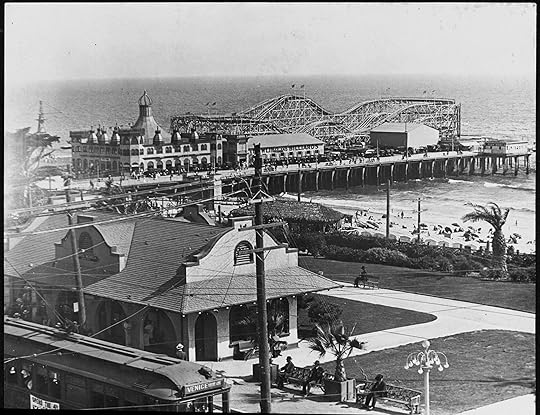
Above, the wife waits for the next train. This was likely filmed at the Santa Monica trolley stop along Ocean Ave., pictured above. Huntington Digital Library.
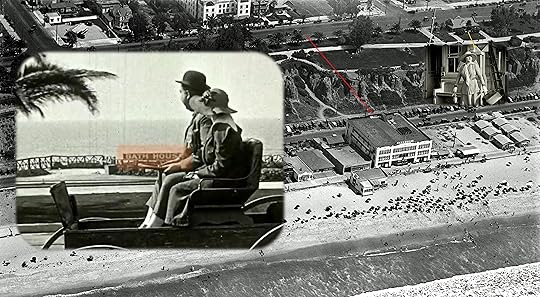 Click to enlarge – the “BATH HOUSE” appearing with Mack lines up with this Bath House below the palisade, which also bears an identical “BATH HOUSE” sign on the front. The wife’s likely trolley station also appears (inset upper right). Huntington Digital Library.
Click to enlarge – the “BATH HOUSE” appearing with Mack lines up with this Bath House below the palisade, which also bears an identical “BATH HOUSE” sign on the front. The wife’s likely trolley station also appears (inset upper right). Huntington Digital Library.
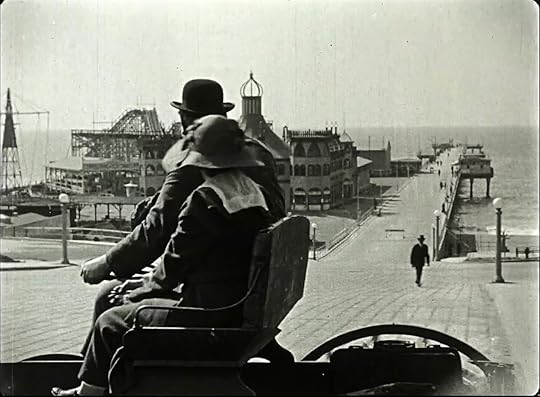

As they continue south, they drive by the entrance to the Santa Monica Pier. What a time travel moment, a “live” motion picture driving by more than a century ago.
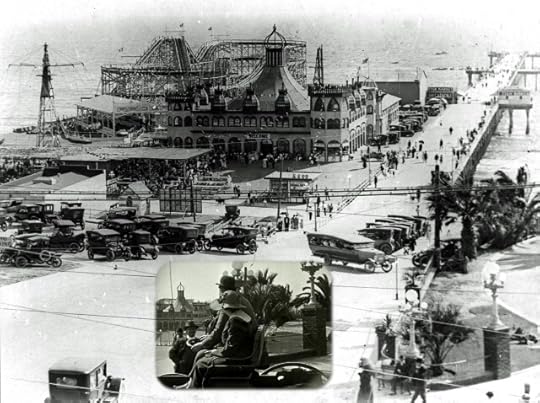 Above, Mack inset with a matching view of the Pier and the prominent Looff Carousel building – notice the front corner lampposts lower right. The carousel would play a prominent role in the 1973 “Best Picture” The Sting. Huntington Digital Library.
Above, Mack inset with a matching view of the Pier and the prominent Looff Carousel building – notice the front corner lampposts lower right. The carousel would play a prominent role in the 1973 “Best Picture” The Sting. Huntington Digital Library.


More than 100 years later the Looff Carousel is still a popular tourist attraction.
 Harold Lloyd filmed By The Sad Sea Waves (1917) and Why Pick On Me (1918) at beach side parks including Santa Monica. At left Harold stands north of the Santa Monica pier in By The Sad Sea Waves that you may read more fully about HERE.
Harold Lloyd filmed By The Sad Sea Waves (1917) and Why Pick On Me (1918) at beach side parks including Santa Monica. At left Harold stands north of the Santa Monica pier in By The Sad Sea Waves that you may read more fully about HERE.


The second reel of Mack’s film is still missing, but toward the end of reel one Mack frolics with some non-Keystone bathing beauties beside the same distinctive rocks where Charlie Chaplin filmed The Adventurer in 1917 – read more How Charlie Made The Adventurer HERE.
 The distinctive rocks beside Mack and Charlie appear near the center, with towering Haystack Rock, now demolished, at the left. USC Digital Library.
The distinctive rocks beside Mack and Charlie appear near the center, with towering Haystack Rock, now demolished, at the left. USC Digital Library.
In closing, Buster Keaton filmed scenes for The Cameraman (1928) on the Santa Monica Pier, when Harold Goodwin drives Marceline Day and Buster home after their date. Buster has to sit in the outside rumble seat, and gets drenched in the pouring rain.
 The scene was staged to look as if filmed on a street – the audience never sees the pier nor the ocean. You can read more How Buster Keaton Filmed The Cameraman on the Santa Monica Pier HERE.
The scene was staged to look as if filmed on a street – the audience never sees the pier nor the ocean. You can read more How Buster Keaton Filmed The Cameraman on the Santa Monica Pier HERE.
You can also see how Buster filmed at the Santa Monica Pier in my YouTube video Caught On Film – Buster Keaton’s The Cameraman, showing not just the locations, Buster’s move to M-G-M and his rented bungalow right outside, but hidden details reveal Buster filmed at long-familiar locales, and near where he had once worked happily with mentor/best friend Roscoe Arbuckle, which must have given Keaton some comfort during this difficult transition in life. Score by Jon C. Mirsalis.
Below, a view of the entrance to the Santa Monica Pier











